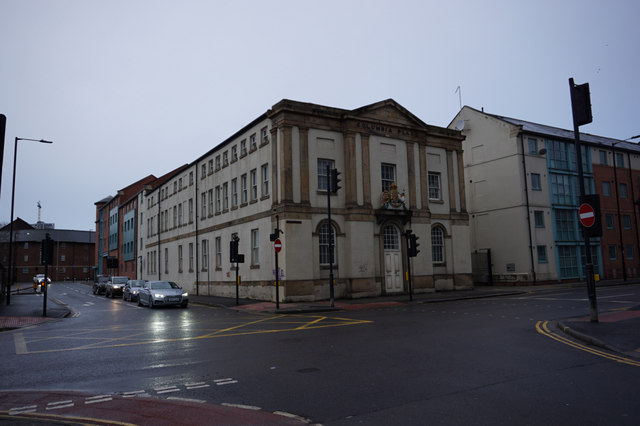Columbia Place on Suffolk Road, Sheffield
Introduction
The photograph on this page of Columbia Place on Suffolk Road, Sheffield by Ian S as part of the Geograph project.
The Geograph project started in 2005 with the aim of publishing, organising and preserving representative images for every square kilometre of Great Britain, Ireland and the Isle of Man.
There are currently over 7.5m images from over 14,400 individuals and you can help contribute to the project by visiting https://www.geograph.org.uk

Image: © Ian S Taken: 20 Jan 2018
Details credited to Dave Hitchborne a follow member of Geograph. Columbia Place was built in Classical Revival style by Thomas Tillotson, as a steel and file works in 1849. It was constructed in local brick and sandstone without stucco and originally occupied 3 floors. Thomas Tillotson is listed in trade directories as a merchant and manufacturer of table cutlery; this works probably fed his other works at Cambridge Street. The 1851 Ordnance Survey map shows the main building, which still stands, with the other buildings on site being unattached and much smaller. It appears that Tillotson did not use the entire site, the northern part of the yard being shared with others - all using the name Columbia Works. Thomas Tillotson remained in occupation until 1860 and the works were then occupied by several different companies, all steel and file manufacturers, until 1868, when William Wigfall & Sons, Brush Maker, occupied the building. William Wigfall & Sons, who remained here until 1871, were commissioned by Royal Appointment and it is likely that this is when the Royal Coat of Arms was added to the building. It is not known who occupied the building immediately after 1871, but in 1876 Brindley and Foster, Organ Builders moved in and remained until 1936. Brindley and Foster were renowned organ builders, supplying the organ for the Great Hall of the Royal College of Organists, St. George's Church in Sheffield and many other church organs. It is thought that they were responsible for removing the upper storey of the main building, reducing it to the present 2 floors. In 1938, Holmes & Younie Ltd., Automobile Engineers, moved in and remained until 1973. Subsequently various other vehicle repair and car dealers have occupied the site, including a petrol filling station for part of this period. The main building was Grade II listed in 1973. It was refurbished and the rest of the site developed into housing, live/work units and offices, by Derwent Living, in 2004.

